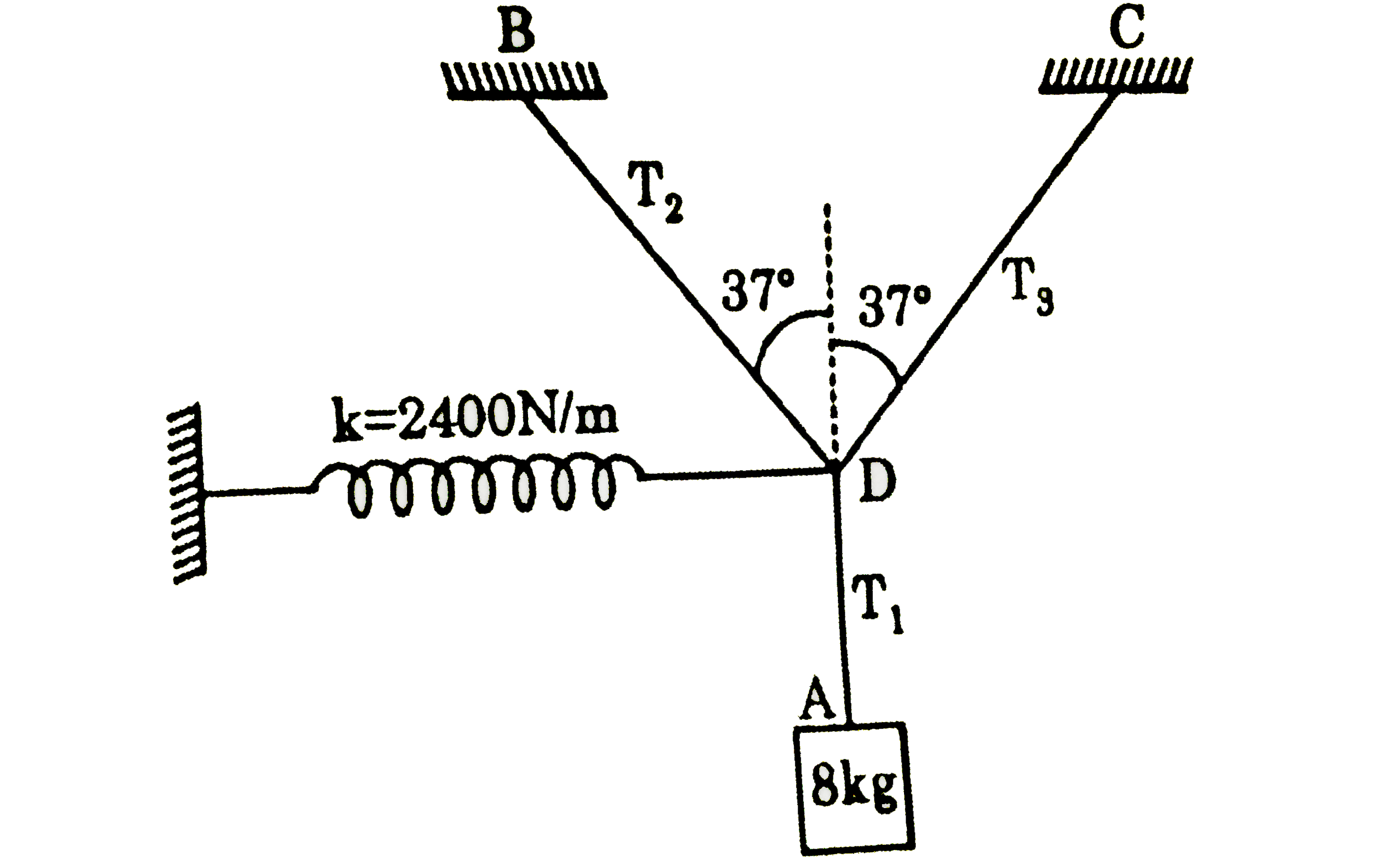If 'O' is in equilibrium then tensions T1andT2 are (Tan 37∘=3/4 )
 Solution in Telugu
Solution in Telugu
30 N, 50 N
60 N, 80 N
80 N, 60 N
20 N, 40 N
The correct Answer is:B
Step by step video & image solution for If 'O' is in equilibrium then tensions T_1 and T_2 are (Tan 37^@ = 3//4 ) by Physics experts to help you in doubts & scoring excellent marks in Class 11 exams.
Updated on:21/07/2023Topper's Solved these Questions
- NEWTONS LAWS OF MOTION BOOK - AAKASH SERIESCHAPTER - NEWTONS LAWS OF MOTION EXERCISE - ADDITIONAL PRACTICE EXERCISE (LEVEL - II (LECTURE SHEET (ADVANCED)) (Straight Objective Type Questions)
12 Videos
- NEWTONS LAWS OF MOTION BOOK - AAKASH SERIESCHAPTER - NEWTONS LAWS OF MOTION EXERCISE - ADDITIONAL PRACTICE EXERCISE (LEVEL - II (LECTURE SHEET (ADVANCED)) (More than one correct answer Type Questions )
2 Videos
- NEWTONS LAWS OF MOTION BOOK - AAKASH SERIESCHAPTER - NEWTONS LAWS OF MOTION EXERCISE - PRACTICE SHEET (EXERCISE - IV) (LEVEL - II) (Straight Objective Type Questions)
2 Videos
- MOTION IN A STRAIGHT LINEBOOK - AAKASH SERIESCHAPTER - MOTION IN A STRAIGHT LINEEXERCISE - Questions for Descriptive Answers
7 Videos
- OSCILLATIONBOOK - AAKASH SERIESCHAPTER - OSCILLATIONEXERCISE - QUESTIONS FOR DESCRIPTIVE ANSWERS
12 Videos
Similar Questions
A lift of total mass M is raised by cables from rest through a height h . The greatest tension which the cables can safely bear is n Mg. The maximum speed of lift during journey if the ascent is to made shortest time is :
View SolutionA particle is found to be at rest when seen from a frame S1 and moving with a constant velocity when seen from another frame S2
a) Both the frames are inertial
b) Both the frames are non inertial
c) S1 is inertial and S2 is non inertial
d) S1 is non inertial and S2 is inertial
View SolutionIn the figure shown the acceleration of A is, →a=15ˆi+15ˆj then the acceleration of B is: (A remains in contact with B)

View SolutionThree tortoises are located at the vertices of an equilateral triangle whose side equals a They all start moving simultaneously with velocity v constant in modulus with the first tortoise heading continually for the second , the second for the third and the third for the first . They will meet after time
View SolutionThe spring shown in figure is unstretched when a man starts pulling on the cord. The mass of the block is M. If the man exerts a constant force F, find the amplitude and the time period of the motion of the block.

View Solutiont1=(sinθ)cosθ,t2=(sinθ)sinθ,t3=(cosθ)cosθ,t4=(cosθ)sinθ (A) t3>t1>t2 (B) t4>t2>t1 (C) t4>t1>t2 (D) t1>t3>t2
View SolutionGiven arrangement is in equilibrium and elongation in spring is 1cm. Tension in string AD is T1, in string BD is T2 and is string CD is T3.Choose correct values of T1,T2andT3:

View SolutionFor a given exothermic reaction, K_P and K_p^' are the equilibrium constants at temperature T_1 and T_2( T_2>T_1) respectively. Assuming the heat of reaction is constant in temperature range between T_1 and T_2 , it is readily observed that
View SolutionIf K_1 is the equilibrium constant at temperature T_1 and K_2 is the equilibrium constant at temperature T_2 and If T_2 gt T_1 and reaction is endothermic then
View SolutionIn the case of a thermodynamic reaction T_1 Oh T_2 (T_2> T_1) Equilibrium values in temperature, respectively K_p Oh (K_p) ') । T_1 Oh T_2 Assuming that the reaction-temperature remains constant within the temperature range ,--
View SolutionIf 'O' is at equilibrium then the values of the tension T_(1) and T_2 respectively.
View SolutionTension for the body shown in Fig. T_1 And T_2 Is the ratio of
View SolutionA 10 kg wt is suspended as shown below then Tension T1 & T2 are

View SolutionThe vertices of a triangle are [at1t2,a(t1+t2)], [at2t3,a(t2+t3)], [at3t1,a(t3+t1)] Then the orthocenter of the triangle is (a) (−a,a(t1+t2+t3)−at1t2t3) (b) (−a,a(t1+t2+t3)+at1t2t3) (c) (a,a(t1+t2+t3)+at1t2t3) (d) (a,a(t1+t2+t3)−at1t2t3)
View SolutionThe vertices of a triangle are [at1t2,a(t1+t2)], [at2t3,a(t2+t3)], [at3t1,a(t3+t1)] Then the orthocenter of the triangle is: (a) (−a,a(t1+t2+t3)−at1t2t3) (b) (−a,a(t1+t2+t3)+a(t1t2t3) (c) (a,a(t1+t2+t3)+at1t2t3) (d) (a,a(t1+t2+t3)−at1t2t3)
View SolutionIf K1 is the equilibrium constant at temperature T1andK2 is the equilibrium constant at temperature T2and If T2>T1 and reaction is endothermic then
View Solution